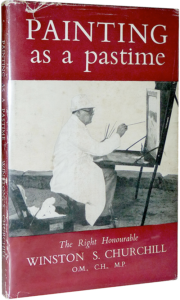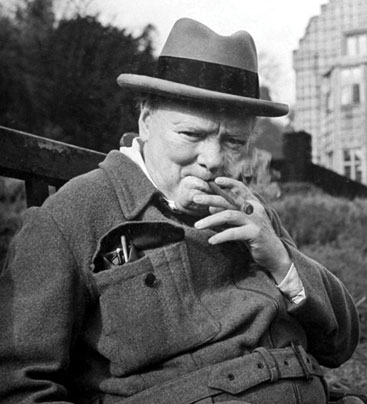CHURCHILL OUT OF HIBERNATION, WEEK 39
PAINTING AS A PASTIME really is the promised gift of springtime. An essay of transcendence celebrating Winston Churchill’s favorite hobby (and, in fact, all hobbies) Painting As a Pastime first appeared in The Strand Magazine over two issues in December 1921 and January 1922. It was then anthologized in Thoughts and Adventures before being published as a delightful little book all its own that we celebrate next in our romp through Churchill’s book-length works.
 Winston Churchill discovered the single most sustaining passion of his life (after his wife and children) in the throes of one of the darkest moments in his life. Having been forced to resign his post as First Lord of the Admiralty during World War One following the disaster at Gallipoli, Churchill was sheltering with his family at his summer retreat, Hoe Farm, watching his brother Jack’s wife, Lady Gwendoline, painting at her easel one Sunday in June 1915. Noticing his fascination and hoping to distract the shattered Winston from his troubles, “Goonie” suggested that he try painting something himself using her six-year-old son Johnny’s box of watercolors. Churchill agreed.
Winston Churchill discovered the single most sustaining passion of his life (after his wife and children) in the throes of one of the darkest moments in his life. Having been forced to resign his post as First Lord of the Admiralty during World War One following the disaster at Gallipoli, Churchill was sheltering with his family at his summer retreat, Hoe Farm, watching his brother Jack’s wife, Lady Gwendoline, painting at her easel one Sunday in June 1915. Noticing his fascination and hoping to distract the shattered Winston from his troubles, “Goonie” suggested that he try painting something himself using her six-year-old son Johnny’s box of watercolors. Churchill agreed.
He never stopped. For the rest of his life, painting would give him solace and a perfect retreat from the stresses of his day-to-day world. He found he could concentrate on painting with the same intensity that he gave to politics, but to the exclusion of politics and everything else. As his private secretary, Edward Marsh, who witnessed Churchill’s initial Hoe Farm forays, later observed, painting “was a distraction and a sedative that brought a measure of ease to his frustrated spirit.”
Returning for another weekend at Hoe Farm on July 2, Churchill painted with oils for the first time. He wrote about this in Painting As a Pastime:
“The palette gleamed with beads of colour. Fair and white rose the canvas; the empty brush hung poised, heavy with destiny, irresolute in the air. My hand seemed arrested by a silent veto. I mixed a little blue paint on the palette with a very small brush, and then with infinite precaution made a mark about as big as a bean . . . so subdued, so halting, indeed so cataleptic, that it served no response.”
Painting as a pastime might have ended right there, but for a fortuitous sudden arrival. A motorcar was heard in the drive. Out of it stepped Hazel Lavery, wife of the eminent Irish painter Sir John Lavery, who would soon become Churchill’s artistic mentor.
“‘Painting!’” Mrs. Lavery cried out. “‘But what are you hesitating about? Let me have a brush—the big one.’”
Hazel Lavery’s fearless aggression with paint inspired Churchill. “Splash into the turpentine,” he wrote in Painting As a Pastime, “wallop into the blue and the white, frantic flourish on the palette. The spell was broken . . . I seized the largest brush and fell upon my victim with Berserk fury. I have never felt any awe of a canvas since.”
We wish you vaccinated good health and the beneficence of a nurturing hobby — or any nurturing distraction, in fact — to carry you through.


